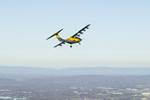Electra’s Goldfinch proves eSTOL capabilities in piloted test flights
Information gained from the flight test program will inform the design of Electra’s nine-passenger commercial eSTOL aircraft, with entry into commercial service targeted for 2028.
In May 2024, Electra Aero’s (Manassas, Va., U.S.) hybrid-electric test aircraft, the EL-2 Goldfinch, achieved its first ultra-short short takeoff and landing (eSTOL) piloted flight. The aircraft features a custom prepreg composite fuselage.
“We’ve proven that our eSTOL aircraft has the capability to do what we said it could do — operate from spaces shorter than 300 feet,” says JP Stewart, Electra vice president and general manager. “The aircraft handling at low-speeds has been exceptional and is matching our analysis well, building confidence in the predicted capability of the nine-passenger product design. We’ll continue to develop our technologies, including the ‘thrust-by-wire’ flight control system to allow us to fly even slower on approach and further improve the STOL takeoff and landing performance in the ongoing test campaign.”
The test flights, piloted by Cody Allee, took place through April and May 2024 at the Manassas Regional Airport and Warrenton-Fauquier Airport in Virginia. The longest flight lasted 1 hour 43 minutes. During the campaign, the aircraft took off in less than 170 feet and landed in under 114 feet ground roll. It reached an altitude of 6,500 feet, and it flew as slowly as 25 knots on takeoff and landing. Data and insights gained from the flight test program will inform the design of Electra’s nine-passenger commercial eSTOL aircraft, with entry into commercial service under FAA Part 23 regulations targeted for 2028.
Electra’s blown-lift design uses eight electric motors to increase wing lift, enabling the eSTOL aircraft to take off and land in just 1/10th of the space needed by conventional aircraft. This enables access to locations that today only helicopters can reach. Quiet electric motors reduce noise and emissions for community-friendly operations. Hybrid-electric power provides long-range capability without the need for ground-based charging stations.
Related Content
-
Cryo-compressed hydrogen, the best solution for storage and refueling stations?
Cryomotive’s CRYOGAS solution claims the highest storage density, lowest refueling cost and widest operating range without H2 losses while using one-fifth the carbon fiber required in compressed gas tanks.
-
Plant tour: Albany Engineered Composites, Rochester, N.H., U.S.
Efficient, high-quality, well-controlled composites manufacturing at volume is the mantra for this 3D weaving specialist.
-
Infinite Composites: Type V tanks for space, hydrogen, automotive and more
After a decade of proving its linerless, weight-saving composite tanks with NASA and more than 30 aerospace companies, this CryoSphere pioneer is scaling for growth in commercial space and sustainable transportation on Earth.














